Future Studies in Brazil CGEE Approach for Bio- and Nanotechnology
Abstract: Companies and governments are increasingly using “Future Studies“ for the design of their strategic planning. Techniques and methodologies are in a very accelerated development all over the world. So it is necessary to establish the right set of tools and best way to use it in order to have results that you could compare and reproduce if you have in mind to generate inputs for either companies or countries policy definition. This article describes the methodological approach adopted by a Brazilian Institution – Centre for Strategic Management and Studies – CGEE, mainly devoted to future analyses, and uses the recent examples of the Biotechnology and Nanotechnology foresight exercises in Brazil to show the real use of their results in the process for definition of national strategies.
Introduction
Considering the increasing complexity of the decision making process, the speed of the technological changes and its economic and social impacts, the markets interdependence and the need of support for information coming from formal and informal sources internal and external to the organization, it is obvious that an organization, nowadays, depends more and more on an efficient system of knowledge management.
Considering the high levels of uncertainty with which the society is confronted, the area of strategic planning is being shifted from the traditional approach to a more dynamic one that considers the changes of current times. The studies developed under the denomination of foresight fill the space where there is an intersection between the fields of strategic planning, future studies and policy analysis.
Thus, future studies, foresight and technological forecast are important for strategic planning and for supporting the decision making process and public policies formulation, since they allow the anticipation of technological breakthroughs, trends and discontinuities, new perspectives and opportunities that are presented for a society from the identification of its challenges and potentialities.
Concerning different possible interpretations, the words in Portuguese “prospecção”, “prospectiva”, “exercícios prospectivos” or “estudos do futuro”, as well as its English versions, forecast, foresight, future studies, have become generic denominations – not free of controversies – for the diverse methodologies and approaches that try to answer questions presented by the challenges of the future, either for technologies and its impacts, or for important social issues.
In fact, trying to understand the potential risks and threats, analyzing the future and glimpsing new ways and opportunities that allow the choice of reasonable futures is not a trivial challenge and involves complex questions that must take into account many factors of social and technical nature and different realities and situations.
It is important to emphasize that foresight, forecasting and future studies are fields in constant evolution and that countries and organizations are in search of models, tools, methodologies and concepts that can face the challenges of the future.
This paper presents not only the conceptual and theoretical model elaborated by the Centre of Management and Strategic Studies – CGEE to guide its foresight activities but also some examples of the use of this model, and represent some results already obtained by the Centre.
Science, Technology and Innovation and the role of the Centre of Management and Strategic Studies – CGEE
Brazil and the world are experiencing a significant movement represented by a new look at the importance of science, technology and innovation as transforming agents of the society. The search for solutions on emergent social problems, the formulation of future strategies, as well as the exercise of democratization, that can make possible the participation of the society in the construction of a desired future, points out the necessity to diversify the economic tissue, to rescue cultural values and the process of planning and management of public goods and the environmental questions, preserving the national identity.
Despite its recognition for the exploitation of the economic and regional national potentialities, the Brazilian historical path in the last decades lacks the strengthening in relation to the construction of a nation with a modern economy, integrated to the global markets, with internationally competitive industries, high investments in science and technology, strong ecological conscience and with an operating structure in the concretion of citizens social rights and in the development of the social tissue in more democratic basis.
Initiatives towards structuring a broad spectrum policy of science, technology and innovation, capable of facing some of the emergent questions in the scientific and technological fields, have been part of the national agenda in 2002. This happened, among other factors, as a result of the Brazilian Conference on Science, Technology and Innovation (ST&I) and the publication of the Green and the White Books on ST&I, representing a new movement that stimulated the country to insert the technological innovation as one of the main objectives of the national efforts of science and technology.
In this context, CGEE was created as an institution which aims at promoting and accomplishing future studies and foresight in the field of science, technology and innovation, as well as the activities of evaluation of strategies and economic and social impacts of scientific and technological policies, programs and projects. Moreover, CGEE acts on the dissemination of information, experiences and projects to the society. One of its main features is its capacity of communication and interaction with the science, technology and productive sectors.
CGEE’s strategy was based upon the perception that decision making emerges of a negotiation between multiple actors. This perception was the key point of the methodology known as foresight, which can be defined as a process that leads to a more complete understanding of the forces that shape the future and that must be considered in the formulation of policies, planning and decision making [1]. It means that this approach aims to link the present actions to a strategic perspective, coping with the possibilities of the future for the construction of commitments and coordination concerning the national priorities of research and innovation.
Based upon some of the concepts developed by the European Union, CGEE considers foresight as an activity that connects three different dimensions on the same process: thinking, debating and shaping the future [2].
Moreover, the structuring of communication channels and the process of coordination in different levels points out to the importance of the governance process that must guarantee the validation of technological opportunities identified during the process by the different stakeholders and be transformed into concrete actions by decision makers. Thus, CGEE has a pro-active attitude regarding the future, stimulating the search for an institutional culture of foresight, with a global vision of science, technology and innovation, which estimates complexes mechanisms of interaction, exchange of information, experience and feedback among different involved actors [3].
CGEE’s prospective approach
There is an extensive list of studies related to exploring the future. In a simple examination of literature it is possible to find different denominations for “families” or conceptual structures, such as technological forecasting, technological foresight, social foresight, inclusive foresight, technology assessment, monitoring (environmental scanning, technology watch), prospective networks, roadmapping, scenarios studies, multicriteria decision analysis, etc [4]. This has generated some problems in the terminology. Therefore, the elaboration of simple and direct models and the establishment of different levels of scope and use of such methods, techniques, methodologies and tools becomes rather complex.
As a result, it is common to find techniques developed for specific objectives being used to answer questions of broad and complex nature. This, in certain cases, contributes to discredit this field. This also confirms how difficult it is to face the uncertainties about the future. The reflection on the different approaches is necessary as a way to improve the activity and its results.
Nowadays, the approach called foresight is the most used methodology to assist the establishment of research and development priorities and to promote the alignment of R&D and Innovation policies to the economic and social needs of the countries.
Foresight includes qualitative and quantitative ways to monitor indicators of development trends, and is better and more useful when directly linked to the analysis of policies and its implications. It prepares people for future opportunities.
In the government, foresight does not define policies, but it can help them to be more appropriate, more flexible and more robust in its implementation, in changing times and conditions.
The theoretical model organized to guide foresight in CGEE is presented in figure 1. This model was created taking into account the methodological structure proposed by Horton[5] and improved by the ideas of Conway and Voros[6], as well as the orientations of the Handbook of Knowledge Society Foresight [7] and Godet [8].
CGEE’s approach also considers that many forms of analyzing future technology and its consequences coexist, for example, technology intelligence, forecasting, roadmapping, assessment, and foresight. All of these techniques fit into a field called technology futures analysis (TFA) by Porter et al. [4]. New methods need to be explored to take advantage of information resources and new approaches to complex systems. Examination of the processes sheds light on ways to improve the usefulness of TFA to a variety of potential users, from corporate managers to national policy makers. CGEE methodology tries to have an open mind about the several TFA forms and to introduce new approaches from other fields incorporating new methods and processes to better inform technology management as well as science and research policy.
Understanding the Process
Foresight studies constitute powerful assistants in planning and managing uncertainty levels. However, they must be placed in a planned context, that is, to be based upon pre-established policies and needs. Its effectiveness is intrinsically linked to an adequate methodological proposal and planning, which include: a correct delimitation of the questions to be answered; the type of desired replies; the spatial orientation; the scope of the issue; the strategic focus; the time horizon; the institutional and experts mobilization; the choice of the methodology; the target audience, its extent frequency and reach; the establishment of partnerships; the relationship with ongoing initiatives; the dissemination strategies; the available infrastructure, duration and cost. A very important step is the constitution of a network of stakeholders, able to articulate and reach the necessary consensus and commitments aiming to the implementation of the identified plan of action. (Figure 1)
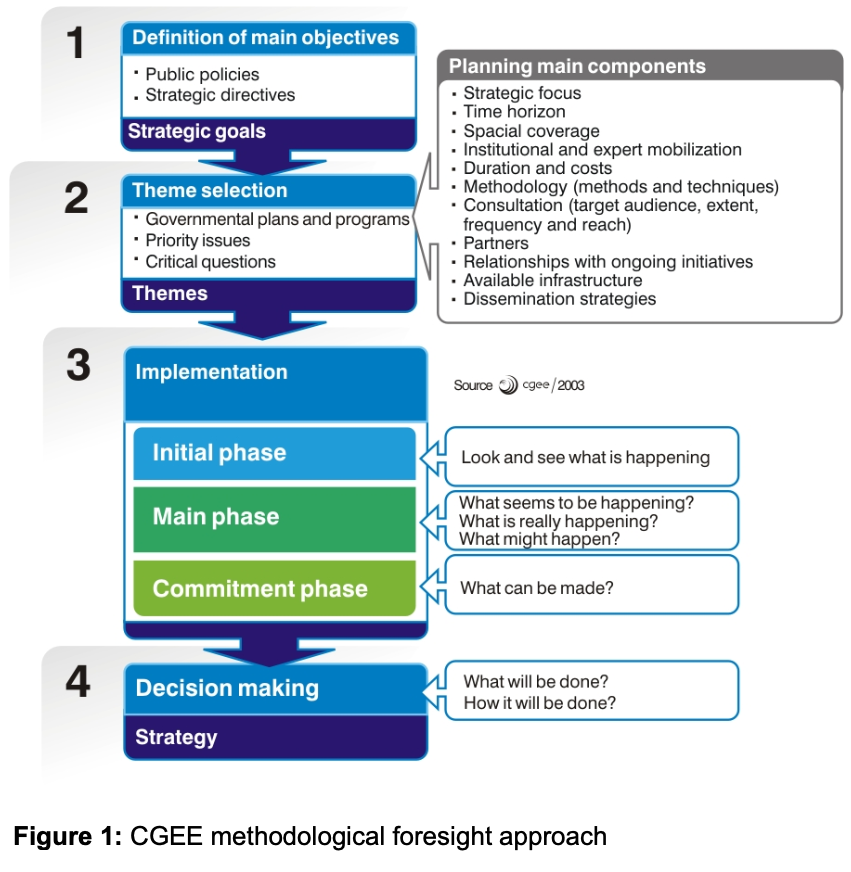
The management of foresight exercises in CGEE tries to follow the theoretical model, considering four great sets for its implementation: definition of objectives, theme selection, implementation and decision making.
Definition of Objectives
The definition of objectives is established between CGEE and its clients, which are mainly governmental institutions, as the Ministry of Science and Technology and the Nucleus of Strategic Affairs of the Presidency of the Republic. The objectives are related to public policies and strategies of the federal government and consider also the characteristics of the subject or sector that will be studied and the arising needs of the Brazilian society. Many times, the studies are anchored in governmental plans and programs, as the studies developed to subsidize the application of Science and Technology Sector Funds. (Table 1)
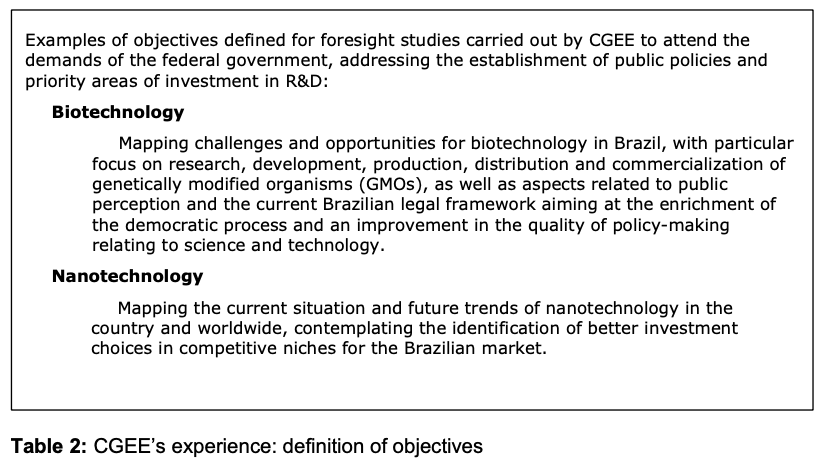
Identification of Themes
Once the strategic objectives are defined, the priority themes that answer the critical questions are selected.
For each selected theme, it is made a rigorous planning, that takes into account the strategic focus, the time horizon, the space scope, the institutional and expert mobilization, duration and costs, the choice of the methods and techniques that will compose the methodology. It also considers the target public of the research, considering its extension, frequency and reach, possible partners of the initiative, the available infrastructure, the relationship with the initiatives in progress and the strategy of dissemination. After all this information is obtained, the exercise can effectively begin. (Table 2)
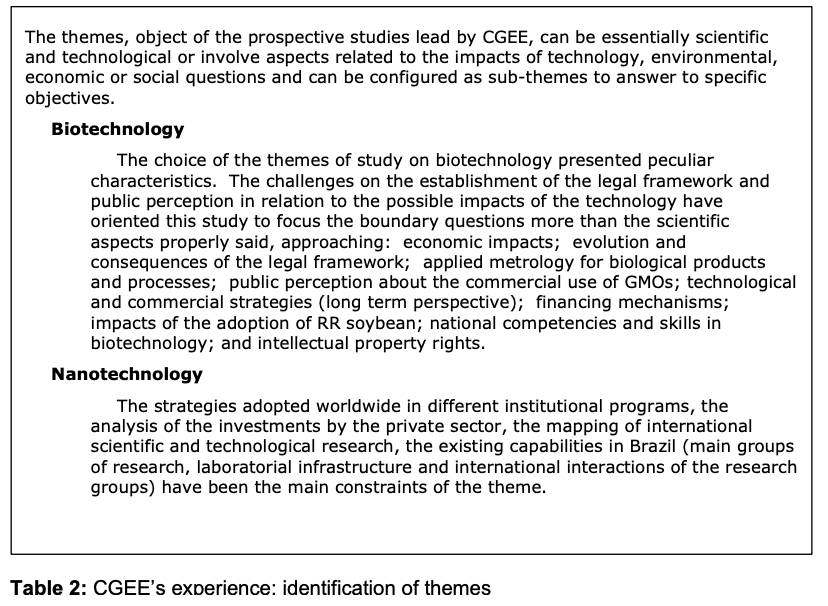
Implementation of the Foresight Exercise
This step, in general, is divided in three phases. Each phase adds value in relation to the previous one creating a chain that turns information into knowledge and knowledge into strategy. Each phase has a higher level of complexity, diminishing the uncertainty level and increasing the potential of contribution of the results to the decision making process.
Initial phase
The question here is: What is happening?
This phase corresponds to the identification of the current situation, and involves the collection, organization and summary of the available information on the theme or subject under analysis, using for this purpose studies, diagnosis, organization and summary of the available information on the theme or subject under analysis, using for this purpose studies, diagnosis, analyses and intelligence systems in order to have a better understanding of the problem. It means the collection and analysis of the explicit knowledge available. Explicit knowledge means: formal models, processes, rules and procedures which can be communicated externally [10].
Elements that can potentially impact the theme/subject under study are identified and delimited as opportunities and threats, forces and weaknesses, and cultural, social, technological, economic, political and environmental factors.
In a complementary way, the experts and other stakeholders are identified and mobilized (Table 3).
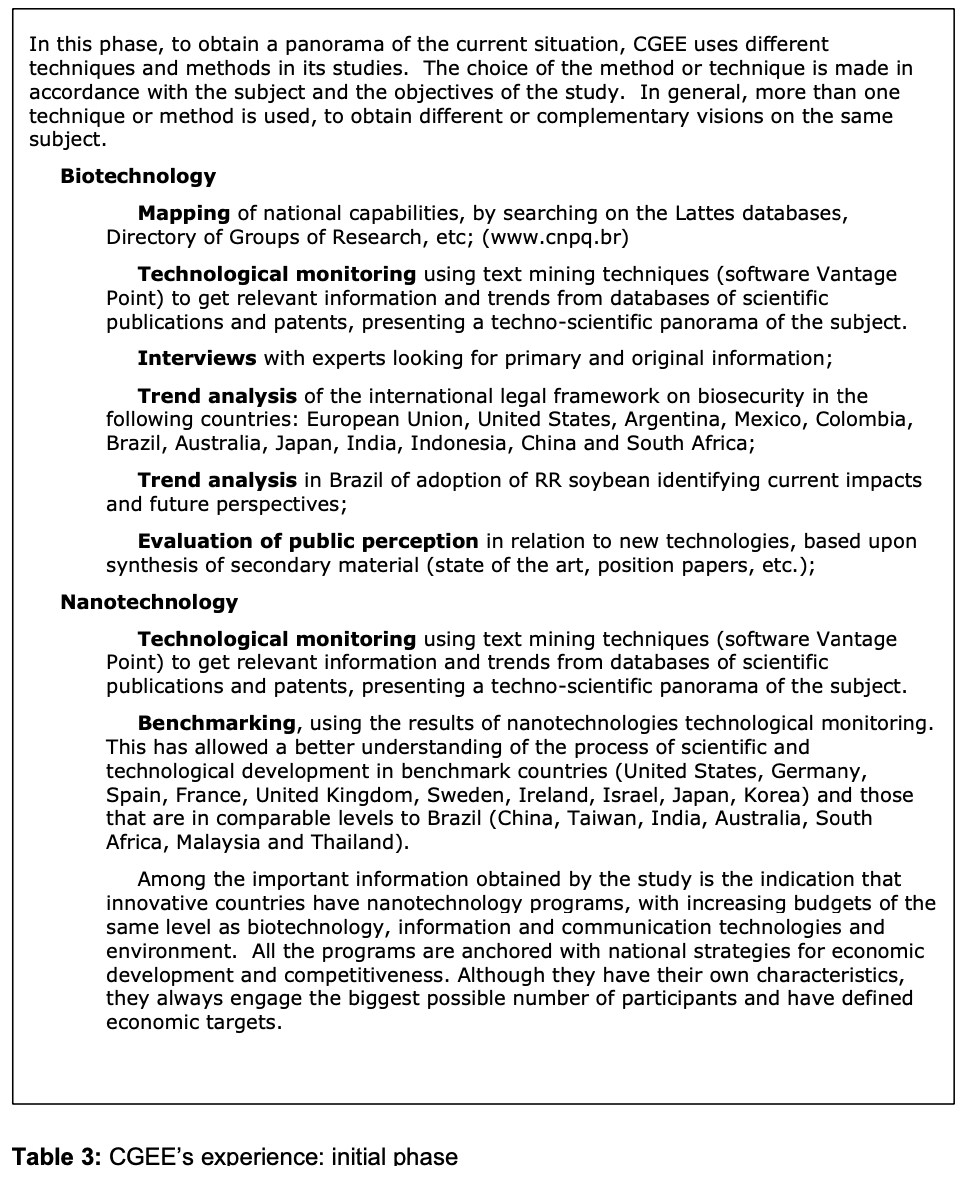
Main Phase
In this phase, the questions are: What seems to be happening? What is really happening? What should be happening?
During the main phase, processes of translation and interpretation concerning the current trends and the future possibilities occur, using forecast and foresight techniques, as Delphi, expert panels, scenarios, etc. It is emphasized, in this phase, the broad participation of experts, groups of interest and decision makers, strengthening networks and collective learning.
The expected result is to empower the existing knowledge with a better understanding of the involved conditionings and the possibilities presented for the future. It represents the integration of tacit knowledge into foresight studies. (Table 4) Tacit knowledge can be defined as a knowledge which is personal, specific to a given context and difficult to articulate in a formal language.[10]
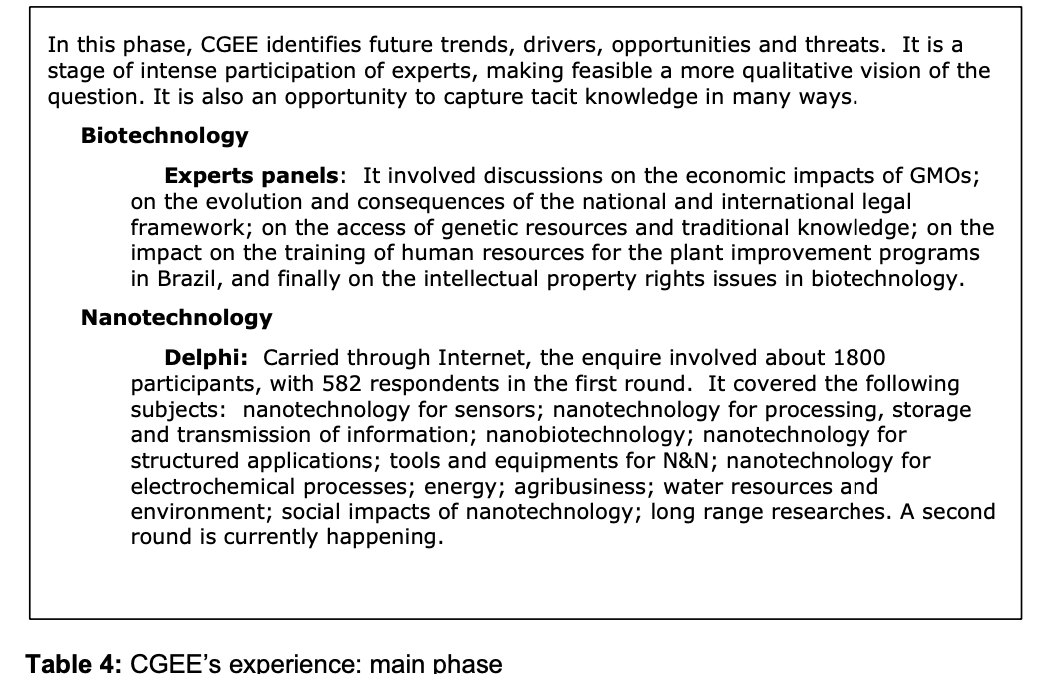
Phase of commitments
In this phase, the question is: What can be done?
Here, it is crucial to disseminate the results and to strengthen the commitment of stakeholders that participated on the previous stages with the decisions based upon the results of the study, with procedures of validation, dissemination and assimilation for a broader public. The expected result is the establishment of consensus and commitments and the transformation of the accumulated knowledge in strategies and proposals that can be taken by the decision makers, searching the expansion of the perception of strategic options. (Table 5)
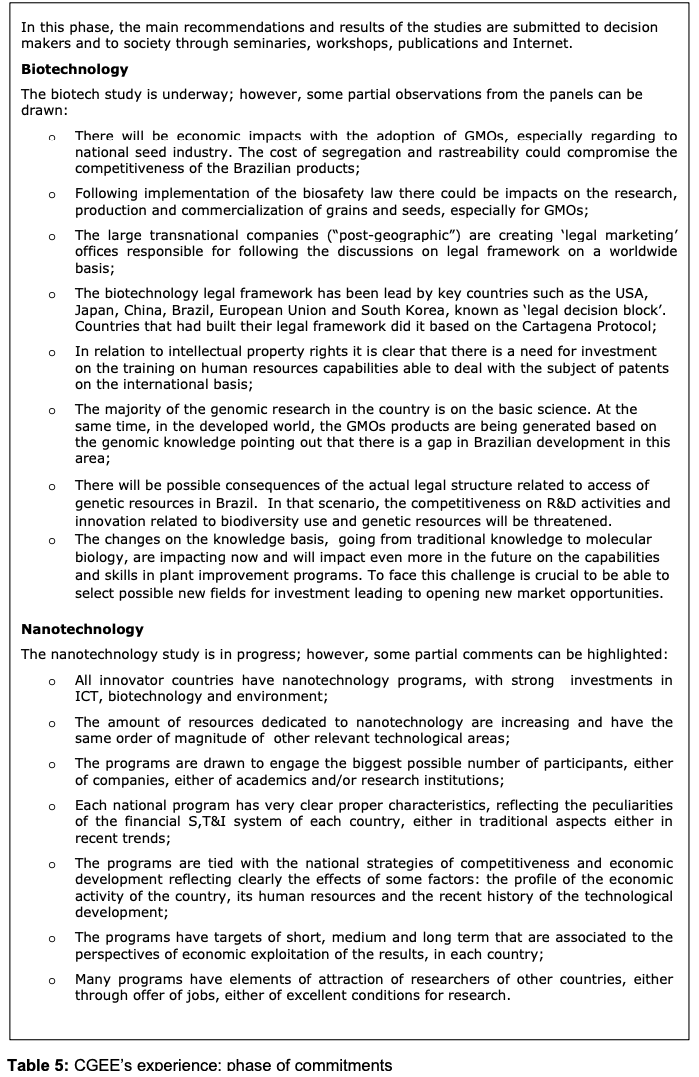
Decision making
Here, the main questions are: What will be done? How will it be done?
The strategic options which seem to be more adequate amongst the identified ones are selected, through interaction with the main decision makers. The expected results involve the definition of mechanisms and tools for implementation of the selected options, as well as the identification of other themes for future analysis.
The commitment of the decision makers during the whole process is essential since it is their responsibility to define what and how things will be done, that is, the final decision belongs to them and prospective studies are only finished when recommendations are put into action.
CGEE’s foresight expanded model
Figure 2 presents the expanded model of the methodology in use by CGEE. The central idea of this approach is to provide flexibility to planning, considering the high level of uncertainty associated with complex and environments of current times.
The final goal of a foresight exercise is always setting priorities to guide decision-making process. However, as pointed out by Skumanich & Silbernagel[9] “forecasting activities cause impacts to organizations (or society) in a variety of ways most of which are extremely difficult to measure. As a result, foresight activities tend to rely on high- level buy-in and public legitimization as sigh of their effectiveness”. (Table 6)
CGEE’s model incorporates different views, methods and techniques, using tacit and explicit knowledge in order to obtain a shared view of the future. It gives consistency to the results of the studies and amplifies the possibilities of its acceptance and usage by the decision makers.
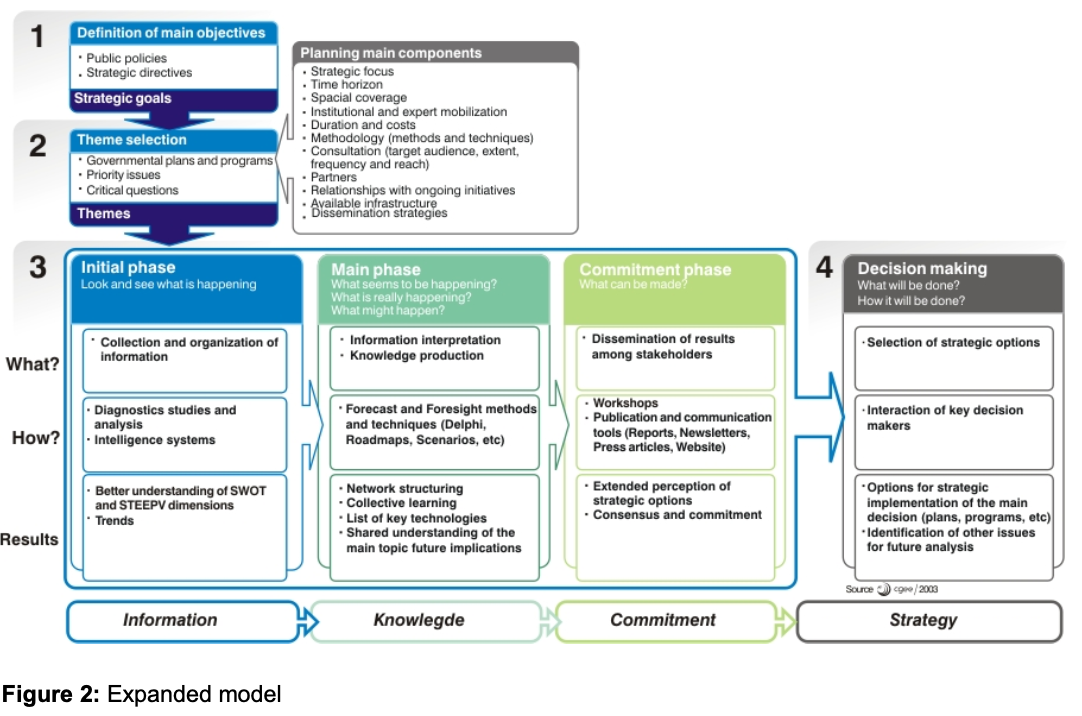
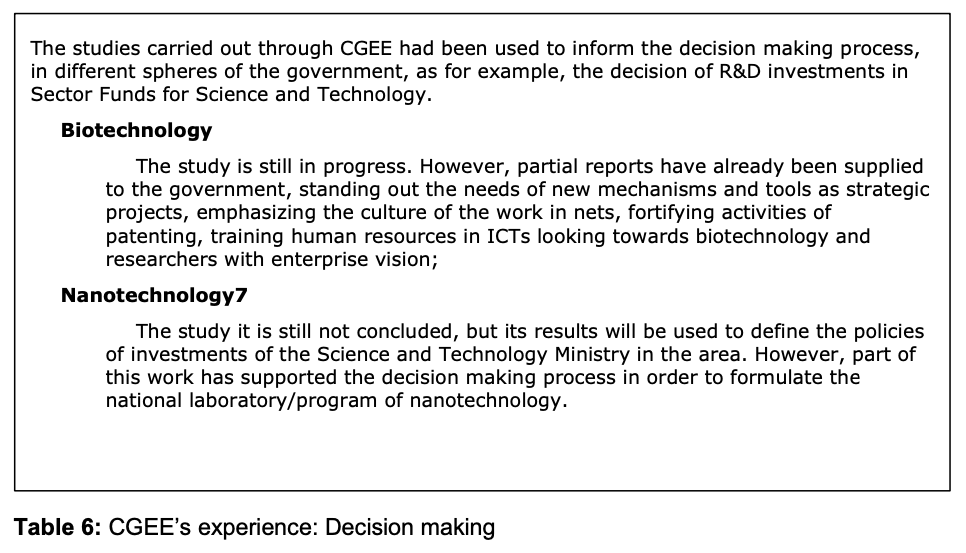
Conclusions: Key Points and Lessons Learned
The creation of visions of the future to anticipate emergent opportunities, potential threats and to indicate trends and priorities is vital for the success of the innovation process and requires permanent monitoring and sharpened perception to catch the indications that allow this anticipation. In relation to the construction of future strategies, the efficient use of the different techniques and existing methods stands out as a basic aspect, in order to comply with the specificities of the problem, as well as the emphasis on participatory approaches, communication networks and horizontal and vertical communication channels.
One of the main tasks in future studies and foresight exercises is the careful and disciplined exploration of representative landscapes of future situations. The information, the knowledge and the perceptions obtained as a result of these activities are used by people and organizations to make decisions, to elaborate strategies and, above all, to get a better view of the future.
The global leadership in any field depends, more and more, upon a change that includes the effective and innovative use of technological management. The key for leadership is in process management of creative ideas, the generation of new technologies, the development and commercialization of new products in existing and new markets. The innovation management tries to congregate mechanisms and tools, methodologies and forms of organization that guarantee the organizations innovative capacity and, as a result, its competitiveness.
Strategic and multidisciplinary themes with a high degree of complexity that involve different and contradictory interests and mobilize the public opinion, require adequate methodological approaches to make possible the decision making based on information of quality, obtained by shared, participatory and articulated means within the academy, government and enterprises with the involvement of representatives of the civil society.
In the particular cases of the studies on bio and nanotechnology conducted by CGEE for NAE (Nucleus of Strategic Issues of Presidency of the Republic of Brazil) the conclusions were used as the main base for the proposition of specific laws and programs of development adopted by the Brazilian Congress and Government as well.
Another important point is related to the need of creation of new tools and approaches that can deal with the increasing trend towards multidisciplinarity and flexibility, necessary to understand the complexity of the current reality, when the models in use seem to be insufficient.
Through the communication and cooperation between researchers, users and financiers, the methodology in use by CGEE looks forward to articulating the search for “visions of the future”. Privileging the knowledge of the environment and the factors that determine the context of the problem, a more effective communication occurs among the stakeholders, which influence the development of science and technology, leading to the strengthening of the technical-economic networks that they participate. Additionally, the activities of foresight developed by CGEE look forward to leverage the process of technological innovation in the country, adding value to the existing information and transforming it into useful knowledge ready to be used.
References
[1] Cuhls, K.; Grupp, H. Alemanha: abordagens prospectivas nacionais. Parcerias Tecnológicas, n.10, mar.2001.
[2] Santos, D. M., Santos, M. M. A atividade de foresight e a União Européia (EU). Parcerias Estratégicas, n. 17, 2003.
[3] Santos, M.M. et al. Prospecção em Ciência, Tecnologia e Inovação: a abordagem conceitual e metodológica do Centro de Gestão e Estudos Estratégicos e sua aplicação para os setores de recursos hídricos e energia. Parcerias Estratégicas, n. 18, 2004.
[4] Porter, Alan L. et al., Technology futures analysis: towards integration of the field and new methods.Technological Forecasting and Social Change, n. 49, 2004.
[5] Horton, A., A simple guide to successful foresight. Foresight – The journal of future studies, strategic thinking and policy, v.1, n.1, Feb. 1999.
[6] Conway, M.; Voros, J., Implementing organizational foresight: a case study in learning from the future. In: Probing the future: developing organisational foresight in the knowledge economy, July 2002.
[7] Miles, I.; Keenan, M. & Kaivo-Oja, J. Handbook of knowledge society foresight. Manchester: Prest, 2002.
[8] Godet, M., Creating Futures – Scenario Planning as a Strategic Management Tool. 269 p. Econômica Ltd., 2001
[9] Skumanich; Silbernagel (1997), Foresighting around the world. Battelle Northwest Lab. Apud Gordon, T.J.; Glenn, J.C. (1999) Factors required for successful implementation of futures research in decision making. Atlanta, Army Environmental Policy Institute, p. iii.
[10] Nonaka, I; Takeuchi, H (1991). The knowledge-creating company. Oxford University Press, 1995